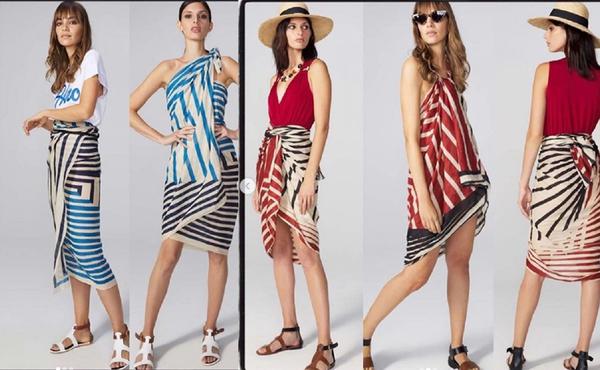The adolescence of the 'minishorts': hypersexualization or fashion?
They wear impossible shorts and t-shirts that end long before reaching the navel. They, pants dropped revealing underwear, but much more comfortable and without the same sexual connotation. This could be the description of the way many adolescents dress, but is it a generational issue that “only” brings parents who cannot understand it to their head, or is it the most obvious consequence of a hypersexualized society?
For Alba Castellví, educator, sociologist and mediator specializing in children and adolescents, the choice of clothing is important for everyone, not only for adolescents, since it not only has a practical utility, but is also socially codified: "Dressing is a game with multiple meanings that talks about us: our social position, our character... Clothes are a message that we send out about who we are and even how we want to relate to others. Teenage girls want to announce that they are no longer girls and want to be liked. Belonging to a group and having the approval of the environment is a very accentuated need among many adolescents. Belonging is expressed through physical appearance and approval is easily achieved by assimilating with others. This explains a certain uniformity in dress: minishorts, for example, have become universal among the female youth population”.
Growing up in a hypersexualized society
Now, for Kepa Paul Larrañaga, sociologist and president of the Association of the Sociology of Childhood and Adolescence Group (GSIA), since everything that happens to economic, social, political and cultural level affects any social and human group, adolescents do not escape external influences either. Therefore, for the sociologist, it is evident to think that if we live in an environment in which hypersexualized content dominates the media and the Internet, these also influence the adolescent social group, "not as a sexualized social group in itself we compare it with the rest of the adult social groups, but rather as a consequence of the society in which they live: macho and that reifies the female body”.
The sociologist Alba Castellví defines hypersexualization as "the instrumental focus of the person through their perception as a sexual object" and points out that "there are many girls who value themselves above all based on their sexual attractiveness, which enhance to the maximum, and this begins soon: the sociologist Neil Postman already spoke in 1994 of "the disappearance of childhood" in his book The disappearance of childhood, in which he exposed the thesis that childhood is lost because of its new conception as a consuming public. Today we see it very clearly: even girls are used as objects when they become models of sexy fashion”.
And it is that women's fashion and especially youth fashion are a clear expression of the hypersexualization of contemporary Western society. According to the historian Paula Martos, with the development of fashion magazines and the appearance of shopping centers in the 19th century and, later, from the 1920s, with the popularization of fashion trends and their extension to all social strata, women's clothing has followed the path of sexualization. “In the 20th century there are some particularly significant models such as pin-up girls, whose peak occurred in the 1940s. The model of the so-called femme fatale also stands out from this time, and in the 1980s there was a complete revolution in clothing, which mainly affects young people. There are many milestones: the corset, the bra, the heels, the stockings, the miniskirt, the bikini... as well as the gradual disappearance of clothing that reaches its peak with the topless”. And it is this disappearance that leads us to the question of whether wearing fewer clothes is a liberation for the body or is it a way of sexualizing it. In the historian's opinion, both concepts are equally valid: “On the one hand, if we understand that female sexuality has been repressed and has tried to free itself, then it will be “liberating”. The problem is that normally this "liberation" has been produced from the male gaze, from the patriarchal mentality, from a fashion industry dominated by men, so it could also be understood as a form of sexualization”.
This idea is shared by the sociologist Kepa Paul for whom "the way we dress reflects a model of social expression that affects adolescents and adolescents who want to dress in a provocative way, insinuating the fact that they can be free even if they are promotes the preservation of obvious gender stereotypes, and without forgetting that it equally affects all adults who dress in the same way in a provocative way”.
The influence of social networks and the internet
It is impossible to close our eyes to a reality, technology, and especially to how it has been integrated into most areas of our lives, from the personal and family to work. And not just as adults. According to Kepa Paul Larrañaga, various European studies place the average age for starting to use social networks and the Internet at around 6 or 7 years. Taking into account that it is around the age of 10 when gender stereotypes are integrated, there are many stimuli to which adolescents have been exposed "in relation to the social assumption of their gender role and therefore of socially linked stereotypes." to that gender role. For the sociologist, “it is enough to observe the number of photos on social network profiles where both adults and adolescents are presented with sexualized images. All framed in a society that continues to want to physically appear young or even adolescent to be more sexually attractive.
Since adolescents shape their own social identity through peer relationships, but also family, social and school environments, it is important to analyze what messages we continue to send as a society in terms of gender roles, stereotypes , cult of the body and hypersexualization. Nora Rodríguez, pedagogue and founder of the Happy Schools Institute, believes that we must go beyond the concept of hypersexualization in the use of a certain style of clothing and we must look at what today's adolescents are like and who influences them. “It's not just a fashion style they use to get noticed, we're talking about iGens, the first generation of teens whose lives are shaped by mobile technology and social media. The way they dress stems from the ubiquitous use of the iPhone, with an inflated individualism. Teens grow up with mobiles, and they have an Instagram page before they start high school. They spend five to six hours a day texting, chatting, gaming, surfing the web, streaming and sharing videos, and hanging out online; And all taking into account, in addition, that girls are incredibly vulnerable because they use social networks more, and report twice the rate of cyberbullying than boys.
What to do? For the pedagogue, teachers and families should walk towards the construction of a more critical thinking in a society in which marketing revolves around sexuality. “Clothes are sexualized, not teenagers. They don't want to be left out so we need to teach teens that new media marketing always benefits the seller, not necessarily the buyer."
According to Alba Castellví, for her part, “the family must act, as far as possible, as a filter in the bombardment of messages from the market and also as a protector of self-esteem and guarantor of the resistance capacity of girls and young people” which suggests that as parents we consider things much earlier: “First of all, when their daughters are still small, parents must be preventive agents. To do this, they have to avoid projecting the image of their daughters. Using them on networks like Instagram to show an image of success, of a pretty girl, implies conveying the idea that appearance is important, and girls will soon learn from their mothers to consider it this way. He adds that fathers and mothers must be aware and critical about the meaning of sexualized female fashion: "They must become aware of how the image infects them with roles or archetypes, and the values to which they are associated: seduction, attractiveness as a value supreme..." And, finally, she adds that what is most important must be done from an educational point of view, through appropriate communication processes that invite girls to ask themselves: "Am I freer, dressing like everyone else, or am I freer?" less? What or who suggests how my image should be? What preferences does it obey and why?



